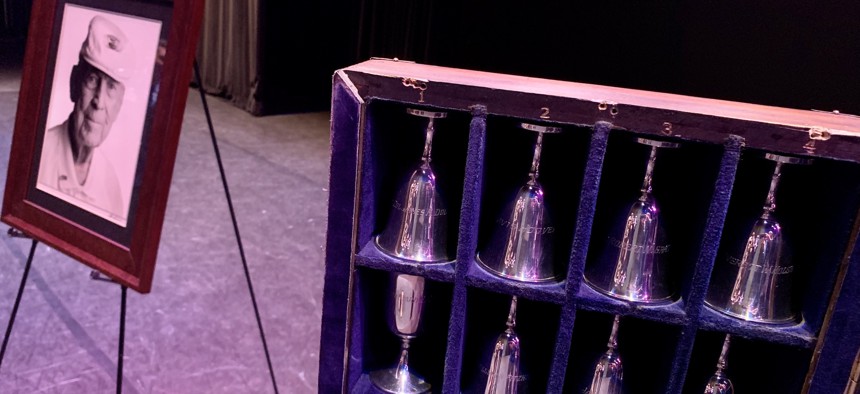
The Air Force and surviving family members raised a final Hennessy cognac toast to the Doolittle Raiders to mark the passing of the last Doolittle Raider. The children of the late Lt. Col. Dick Cole, who served as Lt. Col. Jimmy Doolittle’s co-pilot in the lead B-25 Mitchell bomber, turned over his silver goblet at a ceremony in Fort Walton Beach, April 18, 2022. There were 80 goblets made, one for each U.S. Army Air Forces aviator that conducted the historic secret raid on Tokyo on April 18, 1942. Cole’s goblet is still upright in the case, directly below the first goblet, top left, of Jimmy Doolittle. Defense One / Tara Copp
Air Force Raises a Last Glass to the Final Doolittle Raider
The children of Lt. Col. Dick Cole say farewell to the last of 80 men who flew the historic 1942 mission.
FORT WALTON BEACH, Fla.—Eighty years ago, on April 18, 1942, sixteen B-25B Mitchell bombers heavy with fuel, munitions, and little else launched off the flight deck of the USS Hornet on a one-way mission to Tokyo.
The U.S. Army Air Forces’ Doolittle Raiders became instant heroes, energizing a country still reeling from Pearl Harbor. Eighty men flew the secret mission; 61 survived the war. In 1946, they held their first reunion, sharing a bottle of 1896 Hennessy VS cognac in honor of the birth year of mission leader Lt. Col. Jimmy Doolittle.
Every Doolittle Raider had a silver goblet engraved with his name. At the annual reunions that followed, survivors would raise a toast of Hennessy to Raiders who’d passed the year before, and then turn those Raiders’ goblets upside-down in their velvet-lined case.
Today, the final goblet was turned.
“To those who have gone,” Air Force Secretary Frank Kendall said, drink raised, as the children of Lt. Col. Dick Cole, the last Doolittle Raider, took out their father’s goblet, turned it over, and placed it for the last time in its plush blue casing. It was the centerpiece of a ceremony in which Air Force leaders and generations of Raider family members said a final goodbye to all 80 of the crew.
The Doolittle Raid succeeded because planners and crews alike refused to believe the difficult was impossible. B-25 Mitchells, designed to fly from conventional airstrips, took off that day in less than 500 feet—from a wet and heaving flight deck while bearing a ton of bombs and extra fuel bladders. The Navy gave the Army aviators what help they could by timing each launch to give the plane an extra push into the sky.
The bombers themselves were engineering feats. Doolitte and his crews stripped everything of excess weight—even the classified Norden bombsight—off the aircraft. They’d be flying too low in the surprise attack anyway and the bombsight worked best at higher altitudes. Off it went; a makeshift bombsight of light wire was hand-designed in its place. They stripped 230 pounds of radio gear, replaced the rear guns with wooden dummies, and designed a novel bladder that would collapse as fuel was consumed, giving each crew of five a little more elbow room.
The morning of April 18, 1942, Cole was assigned to fly as Doolittle’s co-pilot. He was on his way to breakfast in the ship’s mess when the Raiders were ordered to their aircraft. They were still several hours and 200 miles away from their launch point when the Navy detected a Japanese ship and feared they’d lost the element of surprise.
“The PA announced, ‘Army pilots, man your planes!’” Cole told HistoryNet.com in a 2014 interview. The seas were rough and “water was coming up over the bow and causing problems, with the airplanes beginning to slip around on deck,” Cole said.
At the Florida ceremony, Air Force Chief of Staff Gen. C.Q. Brown, Jr. said it was notable that Cole was on the lead aircraft, not only because he and Doolittle were leading the mission to Japan, but because as the first plane off the Hornet, they had the least amount of runway.
But those rough conditions and wind also helped all 16 bombers get off deck and reach their target. Flight deck crews timed the release of each bomber just as the carrier was cresting, so as the bomber gathered speed, “the carrier just dropped out from underneath the airplane,” Cole told HistoryNet.
Not all of the 80 men who took off from the Hornet made it home. Three died as the low-on-fuel bombers raced to reach China’s coastline before crashing. Eight were captured by the Japanese in China; of these, three were executed and one died of starvation and mistreatment as a POW.
Cole gave the last Raider toast for the group in 2017, when he became the group’s final surviving member. He’d also built the wood and velvet-lined carrying case that held each of the goblets, and is now cared for by the National Museum of the United States Air Force.
And when former Air Force Secretary Deborah Lee James announced that the nation’s future B-21 stealth bomber would carry the Raider name at a 2016 Air Force Association conference, Cole was in attendance.





